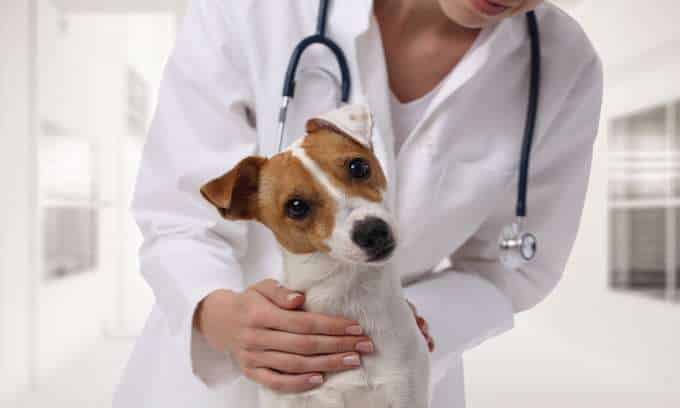How Often Should You Take Your Dog to the Vet

As a pet owner, you might be wondering whether you should take your dog to the vet for a checkup. Taking your furry friend to the veterinarian for vaccinations, checkups, and other routine doggy care is a great way to ensure your dog is healthy and happy.
According to the American Veterinary Medical Association, dogs should see the vet at least once a year. That’s because their annual physical exam and vaccinations can help them live longer and healthier lives.
While there is no specific answer as to how often you should take your dog to see the vet, there are some guidelines you should follow to ensure that your pet is healthy and happy. Continue reading to get some tips on how often you should take your dog in for a vet visit.
When To Take Your Dog To The Vet?

The most critical time for regular vet visits is between 8 weeks and 16 weeks of age—this will allow your vet to check on their growth, vaccinate them against common diseases like distemper and rabies, and ensure that they have no other health issues before they head into adulthood!
After 16 weeks old, it’s recommended that you schedule annual examinations with your vet every year or so until they reach their senior years (around 10 years old).
Factors Affecting A Visit To The Vet
We all know how much dogs love going to the vet, right? They’re always so excited when they see their favorite doctors (or vet) coming over!
But how often should you take your dog to the vet? How do you know when your senior dog needs a checkup? Well, there are a few factors that affect this.
Age
Age is probably the most critical factor in determining how often you should take your dog for a checkup. Adult dogs typically need to have regular visits with the vet.
As your dog gets older, it’s important to schedule regular checkups as soon as possible. This is especially true if you have a senior dog with any kind of health problems or conditions—like diabetes or heart disease—that require special care. You want to ensure those conditions are being managed properly and treated appropriately.
Again, the vet should check the pup’s health status more often (under one-year-old). This is because younger dogs are still growing, developing, receiving vaccinations, and being treated for any health issues they may encounter. Senior dogs tend to be more stable and healthy, so they can go longer between routine wellness exams and appointments before needing anything complicated like emergency care or surgery.
Size
Small dogs tend to live longer than large dogs, so if you have a small breed like a chihuahua or Maltese, it might be worth making sure they go once every six months or so for their annual wellness exam. Larger breeds like German shepherds or great Danes may need to go in more often—once every three months or so.
Bigger dogs usually require more frequent vet visits than smaller ones. This is because they tend to get injured more regularly—they’re not as agile or nimble when it comes to avoiding hazards on the street or at home (like stairs). Additionally, most large dogs need a checkup once a year, and some might even require more frequent visits depending on the dog’s health history and lifestyle.
Smaller breeds are also less likely to hurt themselves because of their size. Be sure you’re keeping track of your dog’s height when making appointments, so everyone knows what kind of attention they need! Smaller breed dogs are generally good candidates for going twice a year or less—but this depends on their health history and lifestyle.
Breed
Breeds that were originally bred as hunting dogs (like retrievers) tend to have shorter lifespans than other breeds due to their tendency to get injured easily while training or hunting. They may also be prone to specific health issues like hip dysplasia if they don’t get enough exercise early in life.
Some breeds are more prone to specific health issues than others. For example, German shepherds are prone to hip dysplasia, while border collies tend to suffer from eye diseases like glaucoma and cataracts.
Some breeds are particularly prone to certain diseases or conditions—these include Doberman pinschers and German shepherds, which are both prone to cancer and hip dysplasia, and great Danes which are prone to bloating.
If your dog’s breed is famous for having any particular health problems, then you should be especially vigilant about taking them in for regular checkups with your vet for your pet to stay healthy.
When To Visit The Vet Immediately
A few symptoms indicate that it’s time for your adult dog to visit the vet immediately. Call your veterinarian or go directly to the emergency room if you notice any of these symptoms.
1. Fever
If your dog has a fever above 103°F (39°C), they need to see a vet immediately. Any fever can cause problems in senior dogs, but if it gets too high, it might be cause for concern or even life-threatening. Be sure to call your veterinarian if this happens!
2. Excessive Vomiting or Diarrhea
If your dog has been sick or has been vomiting or having diarrhea for more than 24 hours, it’s time to call the vet. You can also contact them if they start vomiting suddenly for preventative health care.
3. Vomiting Blood or Blood in Their Stool
If your dog is vomiting blood, call the vet immediately! It could be something serious like gastritis or internal bleeding, so get them checked for preventative care as soon as possible.
4. Swelling Around Their Mouth or Eyes
If your dog is drooling excessively or having trouble swallowing, this could mean they’ve swallowed something sharp like a bone or stick. When in this situation, visit a vet immediately.
5. Loss of Appetite
Always keep a watchful eye out for your dog’s appetite. If they’ve lost interest in food or aren’t eating as much as usual, that’s a red flag. If you’re worried about your pet’s diet, talk to your vet about increasing their intake of protein and vitamins by adding supplements—they’ll be able to help you figure out what works best.
6. Dogs Who Are Acting Lethargic or Depressed
If your dog is acting very lethargic or weak (and not just after exercising), it may also need medical attention. This could mean anything from something simple like dehydration or pain from an old injury (like arthritis) becoming worse. This can even mean kidney failure or other severe conditions that would require immediate veterinary attention.
7. Trouble Breathing
If your dog has trouble breathing, this is another symptom that should send up red flags. Watch for coughing fits or shallow breathing—your dog might need oxygen therapy from a vet if this happens often enough!
8. Unexplained Bleeding
Unexplained bleeding should also prompt only veterinary attention ASAP. This could mean something serious like an internal injury that needs immediate attention before it becomes life-threatening!
9. Obvious Signs of Pain or Discomfort (e.g., Limping)
As your dog ages, there are some signs of things that may become more often like panting. However, obvious signs of pain like limping or struggling to keep their eyes open. These symptoms are easy to spot and can indicate a severe problem in your dog’s general health. If you notice any of these things happening with your dog, don’t hesitate to call your vet right away.
10. Any Other Unexpected Change in Your Dog’s Behavior or Appearance
If your adult dogs show symptoms of pain or discomfort or any other unexpected change in behavior or appearance, take them to the vet immediately. It’s essential to be aware of these signs so that you can get help for your adult dogs as quickly as possible.

What A Vet Exam Involves
When it comes to taking your dog to the vet for annual wellness exams, it’s essential to know what you’re getting into. You don’t want to show up and have no idea what the process entails for the sake of your dog’s health.
However, you also don’t want to over-prepare and feel like you’ve got a checklist that needs ticking off when visiting your older dogs.
Here’s a breakdown of what happens during the exam portion of a visit to the vet:
- An examination of the adult dogs’ teeth, gums, and mouth for any signs of problems or disease (e.g., infections or abscesses)
- Examine the animal’s eyes, ears, nose, and throat, and look for signs of infection (e.g., conjunctivitis) or other abnormalities (e.g., discharge from the eyes or nose).
- The vet will record your dogs’ weight and any changes since the last visit.
- The vet may also take urine tests to check for bladder infections or diabetes.
- Checking the dog’s coat for parasites, fleas, and ticks, removing them if found as a tick prevention measure
- Checking all vital signs, including temperature, pulse rate/pulse rhythm, respiration rate/pattern (normal vs. abnormal), mucous membranes color & capillary refill time (normal vs. abnormal), capillary refill time (normal vs. abnormal), blood pressure (normal vs. abnormal), etc.
Cost of Visiting A Vet
Knowing the cost of visiting a vet is important, especially if you’re a new dog owner. You don’t want to be surprised by unexpected expenses, and you certainly don’t want to put your dog in danger by not being able to afford necessary treatments.
Here are some of the most common checkups in the semi-annual visits that your dog should undergo and how much they’ll cost:
- Geriatric screening is a checkup that vets recommend for healthy adult dogs over the age of seven. It looks at the dog’s overall health and fitness, including their eyesight and hearing. The average cost of this exam is $85-$150.
- Allergy exams are common in dogs who suffer from allergies or skin issues like hot spots or dry skin. The average exam cost is $200-$300 per session.
- Dental care: Your dog’s teeth should undergo an annual checkup by a professional to identify potential problems early on and prevent them from becoming larger later down the road (like needing surgery). It costs between $60-$350.
- Emergency surgery: Like any other checkup, a vet may find your dog needs immediate medical attention for a specific dangerous condition during the annual checkup. In this case, the dog can undergo emergency surgery. The cost will depend on the particular procedure to correct the issue.
You can also be smart enough to cut costs by getting a pet insurance policy to cover your annual check-ups. Ask about payment plans for physical exams prior to plan accordingly, and ask for discounts for the vet semi annually visit.
Conclusion
If you like your pets and would never indifferently let them suffer in their sickness, pay special attention to how they feel. If you notice something wrong with their behavior, visit a vet; don’t wait because fear of the unknown may lead them to incurable diseases. If the initial diagnosis points to needing medication like booster shots, don’t delay—give it to them immediately. Finally, visit the vet for monthly wellness exams, ensuring your pet’s health is up to scratch.





